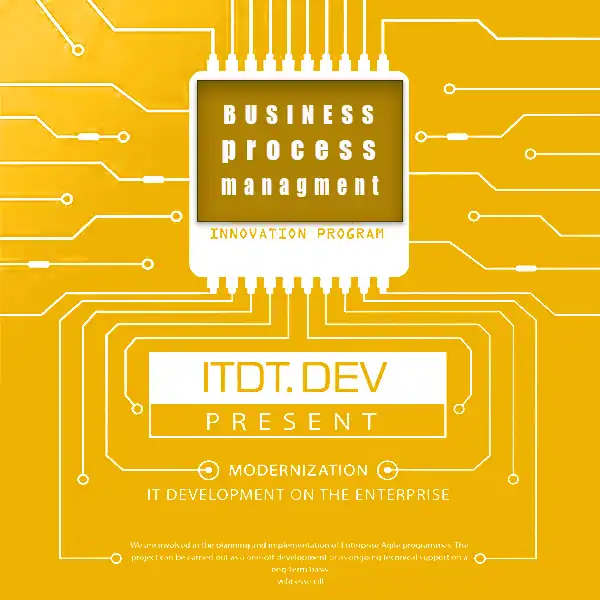
We are the ITdt development team
Our experienced development company has been successfully transforming businesses in various economic sectors for many years. We have a lot to offer today's businesses for their successful growth and adaptation to today's realities. Including business process development.
Often we can observe the term Business Process Management in tandem with concepts such as Six Sigma and Lean. This term usually identifies the underlying business processes, the people who are responsible for these processes, and a number of measures that indicate the state of a particular process. All of the above-mentioned aspects influence the choice of a Six Sigma or Lean project in one way or another.
The ideal development when identifying any processes occurs whether they are independent of any particular structure that is used to carry them out.
A basic concept of bpm is the following:
Every office in an organization is in charge of receiving information or raw materials and then converting them into something different. From the aforementioned, the given processes should be better described:
- Without any consideration of who performs them;
- Without any consideration of how exactly they are implemented.
Business Process Managment
OUTLOOK
Is BPM a task management?
No. Neither is it the management of projects. Business Process Management concentrates (as the name suggests) on the processes (recurring and routine) or directly on the management of processes. With the application of Business Process Management, the functioning of all organizational processes is optimized.
What are the overriding priorities of BPM?
The priorities of BPM are to avoid business processes from becoming chaotic as a result of disorganization and non-systematization. Business Process Management allows you to analyze existing processes and define where inefficiencies exist, as well as determine what key information is needed in any given process.
Using Business Process Management will help you avoid these scenarios:
- High amount of time wasted;
- Large number of mistakes;
- Large number of irregularities;
- Insufficient information;
- Demoralization of staff;
- Low efficiency of business processes
Stages of the business process management lifecycle:
- PROJECT CREATION.
At this stage you need to identify those responsible for each workflow objective. - SIMULATION.
Visualize the procedure. Within the visualized diagram, capture the data on the timing and conditions for execution of the procedure, in order to have a precise idea of the workflow. - EXECUTION.
Make sure that there is limited availability of confidential information and then start implementing the process. You should start by executing it with a few people and then you can release it to the masses. - MONITORING THE PROCESS.
Observe how the process is performed, simultaneously marking the level of success, effectiveness and its weaknesses. - OPTIMIZATION.
During the analysing process, be careful to point out for yourself all the changes that need to be implemented to make the work process more productive. You can refer to a step-by-step guide on how to improve business processes.
PECULIARITIES
that every effective business process management instrument has to have
After giving you some brief information on the reasons why implementing Business Process Managment is essential for a modern organization, we would also like to show you a list of special features an effective BPM system should have:
- A tool for creating clear schedules of production operations;
- Form constructor which allows to move elements easily;
- A role-based access control;
- Mobile support;
- Extensive administrative capabilities;
- Single sign-on (SSO);
- Ability to integrate with existing versions of products;
- Reports and data analysis;
- Efficiency in dealing with multiple client databases;
- Indicators of process efficiency.
3 TYPES
of Business Process Managment
- Integrative Business Process Management;
- People-Oriented Business Process Management;
- Document-Oriented Business Process Management.
INTEGRATIVE
Business Process Managment
This type of Business Process Managment system often deals with processes that take place for the most part among already functioning systems with no manual participation in them. Examples of these systems include ERP, CRM, etc. These systems are good in that they allow the creation of processes rather quickly because of their characteristics.
PEOPLE-ORIENTED
Business Process Managment
Regarding the people-oriented Business Process Managment, it is obvious that it is designed for processes performed by people. Frequently, such processes have many tasks, each of which is assigned to an individual person. These systems differ from the previous ones in that they have an elaborate, coherent, and easy to read interface where notifications can be viewed quickly.
DOCUMENT-ORIENTED
Business Process Managment
EXAMPLES
of using business process management
So is it still worth using Business Process Managment?
Taking into account everything described in this article, we can conclude that Business Process Management systems are really worthwhile, convenient and useful systems, the implementation of which will undoubtedly increase the efficiency of your enterprise and help you to get ahead of the competition.
Want to learn more about Business Process Managment? Contact our manager.
